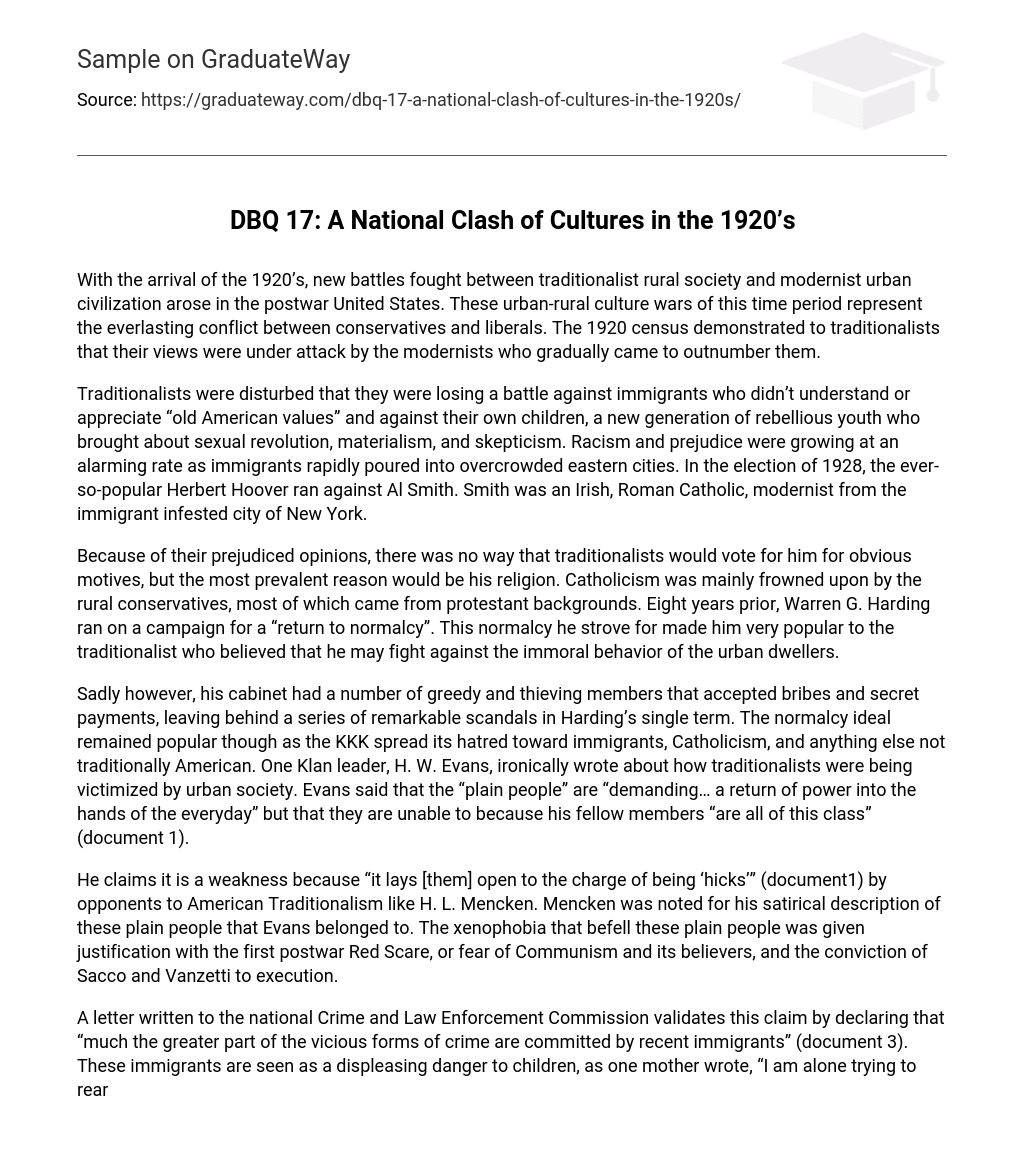With the arrival of the 1920’s, new battles fought between traditionalist rural society and modernist urban civilization arose in the postwar United States. These urban-rural culture wars of this time period represent the everlasting conflict between conservatives and liberals. The 1920 census demonstrated to traditionalists that their views were under attack by the modernists who gradually came to outnumber them.
Traditionalists were disturbed that they were losing a battle against immigrants who didn’t understand or appreciate “old American values” and against their own children, a new generation of rebellious youth who brought about sexual revolution, materialism, and skepticism. Racism and prejudice were growing at an alarming rate as immigrants rapidly poured into overcrowded eastern cities. In the election of 1928, the ever-so-popular Herbert Hoover ran against Al Smith. Smith was an Irish, Roman Catholic, modernist from the immigrant infested city of New York.
Because of their prejudiced opinions, there was no way that traditionalists would vote for him for obvious motives, but the most prevalent reason would be his religion. Catholicism was mainly frowned upon by the rural conservatives, most of which came from protestant backgrounds. Eight years prior, Warren G. Harding ran on a campaign for a “return to normalcy”. This normalcy he strove for made him very popular to the traditionalist who believed that he may fight against the immoral behavior of the urban dwellers.
Sadly however, his cabinet had a number of greedy and thieving members that accepted bribes and secret payments, leaving behind a series of remarkable scandals in Harding’s single term. The normalcy ideal remained popular though as the KKK spread its hatred toward immigrants, Catholicism, and anything else not traditionally American. One Klan leader, H. W. Evans, ironically wrote about how traditionalists were being victimized by urban society. Evans said that the “plain people” are “demanding… a return of power into the hands of the everyday” but that they are unable to because his fellow members “are all of this class” (document 1).
He claims it is a weakness because “it lays [them] open to the charge of being ‘hicks’” (document1) by opponents to American Traditionalism like H. L. Mencken. Mencken was noted for his satirical description of these plain people that Evans belonged to. The xenophobia that befell these plain people was given justification with the first postwar Red Scare, or fear of Communism and its believers, and the conviction of Sacco and Vanzetti to execution.
A letter written to the national Crime and Law Enforcement Commission validates this claim by declaring that “much the greater part of the vicious forms of crime are committed by recent immigrants” (document 3). These immigrants are seen as a displeasing danger to children, as one mother wrote, “I am alone trying to rear [my son] an honorable American but how can I when this foreigner… is allowed to ruin my boy” (document 5). Concern over the new generation also helped to spark the urban-rural culture wars, as this younger age group was influenced by industrial growth and progressivism.
Rebellion was so commonly associated with this new crowd that they became known as the Lost Youth. Prohibition couldn’t do anything to stop these revolutionaries from the consumption of illegal alcoholic substances. Several conservatives blamed them for the loss of traditional moral values and for the growth of corrupt society. The Roaring Twenties, as the 1920’s is often called, is known for the sexual revolution that occurred during the time. Members of the Lost Youth heightened it with their suggestive dancing and odd behavior.
Some young women came to be known as flappers, who cut their hair short and dressed in a way that traditional values wouldn’t accept. Edward J. Tobin, a school superintendent, believed that with the assistance of liquor and automobiles they were responsible “for the destruction of human society” (document 4). With the introduction of automobiles, the world of technology could only magnify on the use of electricity. But with the presentation of these new products, came a sense of materialism and greed that the new generation capitalized on.
The Lost Youth bought state-of-the-art electronics and went to the picture shows more than ever before. Cartoons published by conservative newspapers demonstrated the traditional beliefs of frugality and gratefulness (document 6). These technological advances were condemned by the traditionalist rural people, as they had less access to such things. This wasn’t just a desire for material wealth but it also for true knowledge. The ‘20’s was an era of skepticism that allowed for ideas like evolution to develop. Evolutionary theories were fiercely fought by the rural traditionalists, as is evidenced by the Tennessee v.
Scopes trial. Scopes, a simple biology teacher, was convicted of teaching against Fundamentalism. Frederick Lewis Allen described the case as “a battle between Fundamentalism” and “twentieth century skepticism” (document 2). He made it sound like a joke as he mocked the rural people who attended the trial. He and Mencken would most likely agree that traditionalism is a jest that only serves to hold back the modernists. Most concepts or feelings of this time served to stoke the flames between Traditionalists and Modernists.
In conclusion, the urban-rural culture wars of the 1920’s were the contrasting thoughts of traditionalists and modernists. The issues they fought over involved immigration and the youth of the Roaring twenties. Traditionalists saw foreigners as a threat to their own rural way of life, considering that they mostly lived in the densely sprawling urban environment. The so called Lost Youth rebelled against the traditionalism by adopting the immoral ways of urban society, bringing about a society without less worries of social taboo.





